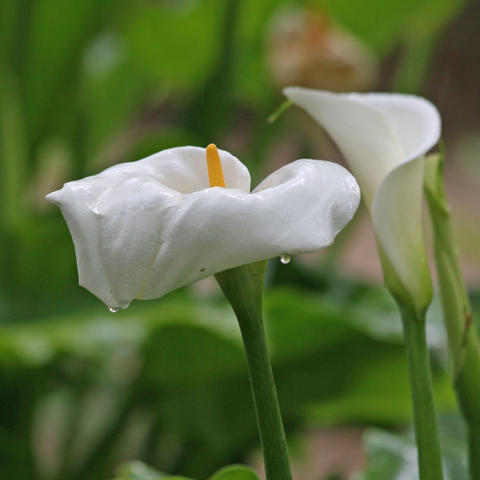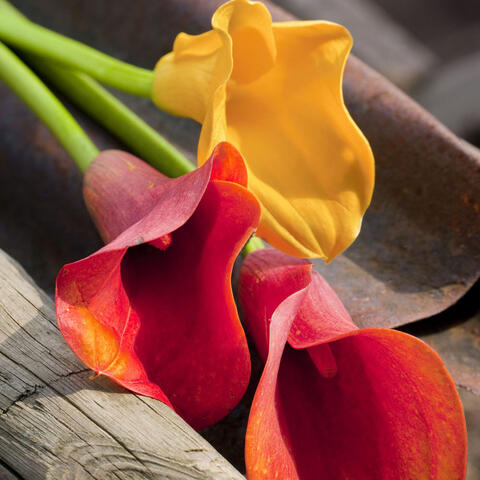Calla lily
The calla lily or zantedeschia is a popular, exotic houseplant. With the proper care, the unusual plant adorns window ledges and balconies with its white, funnel-shaped inflorescences.
Factsheet
- Growth type
-
- Perennial plant
- rhizome
- Growth height (from)
- from 40 cm to 80 cm
- Growth characteristics
-
- upright
- Flower color
-
- white
- Flowering time (month)
-
- February to April
- Flower shape
-
- Pistons
- Leaf color
-
- green
- page format
-
- stalked
- arrow-shaped
- Light
-
- sunny
- semi-shade
- Soil type
-
- sandy to loamy
- Soil Moisture
-
- moderately humid to humid
- ph value
-
- neutral
- Nutrient requirements
-
- nutrient-rich
- Humus
-
- rich in humus
- Decorative or utility value
-
- Flower Decoration
- Toxicity
-
- toxic
- Winter Hardness
-
- frost-sensitive
- Use
-
- Interior greening
- Planters
Zantedeschia aethiopica, also known as the “calla lily” or “arum lily” belongs to the Zantedeschia genus. This limited genus only includes eight Zantedeschia species. Zantedeschia aethiopica originates from South Africa, where it grows in marshy meadows. Zantedeschia has the Italian botanist Giovanni Zantedeschi to thank for its name. The name “calla” is derived from the Greek word “kallos”, meaning “physical beauty”. Zantedeschia are colloquially known as “calla lilies”. However, this name is misleading as there is no botanical relationship between the Zantedeschias and the Liliaceae family.
To add to the confusion, there is also a further plant genus called Calla. However, this only includes a few plant species, i.e. the water-arum (Calla palustris). This calla is native to temperate and sub-arctic climes. The water-arum is very similar to the calla lily. However, its bract is green. The wild water-arum is an endangered plant in Germany today and is under natural conservation.
Zantedeschia grows to around 31.5 inches tall and has fleshy, turnip-like roots (rhizomes). The calla lily can reach stately heights with age and is therefore particularly suitable for large containers. Caution: As with all plants from the Araceae family, the plant parts of the Zantedeschia contain a poisonous liquid. This causes mucous membrane irritation and skin reactions upon contact.
The calla lily forms juicy, green to dark green, broad or hastate leaves. This grow upright from short stalks. The leaf blade is also partially mottled.
As with many Araceae, Zantedeschia also has a pure white bract in its basic form. This covers the inflorescence, which is a yellowish spadix covered in many tiny flowers. The flowering period for the calla lily begins in this region in early spring. Its flowers remain on the plant for three to eight weeks. The inflorescence protrudes above the leaves and can reach up to 3.3 feet tall. The flowers are popular as cut flowers in vases. The color spectrum of the attractive spathaceous bract differs depending on the breed. From white and creme to yellow and orange, right down to vibrant pink, purple and red, and almost black: every color is represented.

Zantedeschia form green or orange colored spherical fruit, similar to berries, after pollination. The seeds are contained in these. As the calla is mainly cultivated as a houseplant at our latitudes, it is generally unpollinated.
Indoors, a sunny to semi-shady place at about 68 degrees Fahrenheit is best for Zantedeschia. In the summer it can be placed on the balcony or patio in a well sheltered spot. In the winter the calla lily should be placed in a bright, cool room at 50 to 59 degrees Fahrenheit. It will gradually acclimatize to the increasing temperatures in the spring.
Humus-rich potting soil is a suitable substrate for the calla lily. Zantedeschia can also be planted in a soil-sand mixture. Tip: Callas also thrive in hydroponics.
Callas are originally marsh plants. The meadows in which they naturally grow in South Africa dry out completely in the summer months. Zantedeschia aethiopica therefore requires plenty of water. Water thoroughly during the growth phases in particular and place the plant in a plant saucer filled with water. You should water the calla lily less after flowering and keep the plants in drier conditions for a few weeks. In this way you can simulate the dry phase the Zantedeschia is accustomed to in its natural location.

You should give the calla lily a standard flower fertilizer every two weeks from spring, when the rising temperatures wake up the Zantedeschia. The calla lily needs these extra nutrients for its growth and flowering phase. You should maintain this rhythm until the end of the flowering period. It is not necessary to give the plant fertilizer during the winter.
You can repot the calla lily in July or August and, if you wish, propagate at the same time by dividing the root ball. As the plant reacts with extreme sensitivity to bacteria and fungus, you should wash the plant pots out well before planting. Change all of the soil as well when repotting the calla lily. In this way you can prevent diseases. Caution: As the Zantedeschia sap is poisonous and can cause skin irritation, you should always wear gloves when working with calla lilies!
Zantedeschia plants do not require pruning. Dead flowers and leaves can be removed. Avoid cutting living, green leaves, as the calla lily needs these for its nutrient supply. The flower stems of the Zantedeschia are extremely long-lasting as cut flowers in a vase.
Spray the Zantedeschia with water low in lime every week during the growth phase. This increases the humidity, which the plant really appreciates. Calla lilies can be placed on the balcony or patio during the summer months. Larger plants can be submerged in flower beds in their plant pots. As Zantedeschia is not frost-hardy, the calla lily should be brought indoors for overwintering as soon as the night temperatures drop. The Zantedeschia should be placed in a bright, cool place during its rest phase in the winter and neither watered nor fertilized.
Today, there is a broad pallet of interesting varieties of exotic calla lilies. The variety ‘Crowborough’ is a fragrant variant that is relatively winter-hardy. However, it only begins flowering in the summer. Zantedeschia aethiopica ‘Perle von Stuttgart’ flowers richly and remains at a relatively low height of 11.81 inches. In contrast, the calla lily variety ‘Hercules’ grows tall. Some varieties such as ‘Flamingo’ or ‘Pink Mist’ are a delight with pink tinged flowers. Zantedeschia aethiopica ‘Green Goddess’ flowers, on the other hand, have flowers with a fresh green colored margin. The variety ‘Black Magic’ has a vibrant yellow bract with a very dark colored center.

Calla lilies are propagated through the division of the rootstock of older plants. This is easiest to do during repotting. After you have loosened the Zantedeschia roots, carefully separate off sections using a sharp knife. Calla lily rhizome pieces are planted about 1.97 inches deep. The soil for propagating Zantedeschia should be about a third each of turf, sand, and potting soil. Freshly planted rhizomes should only be moderately watered. When off-shoots appear you can also increase the watering amount. Set up the young call plants at around 68 degrees Fahrenheit, so that it takes root well. Single-origin calla lilies can also be grown from seeds in temperatures of at least 68 degrees Fahrenheit. However, it usually takes a few years for the first flowers to appear.
If kept dry during the flowering period, the calla lily may develop an aphid infestation. There may also be occurrences of spider mites and scaly insects on the Zantedeschia. If the plant is damaged during maintenance, it is particularly susceptible to plant diseases that are caused by bacteria or fungus. Infested plant parts should be treated generously pesticides and heavily cut back in serious cases. The removed leaves can be disposed of in the household garbage.


